
Sciaenidae is a family of ray-finned fishes belonging to the order Acanthuriformes. They are commonly called drums or croakers in reference to the repetitive throbbing or drumming sounds they make. The family consists of about 293 to 298 species in about 66 or 67 genera.

Argyrosomus regius, also known as the meagre, croaker, jewfish, shade-fish, sowa, kir, corvina, salmon-bass or stone bass, is a species of fish of the family Sciaenidae. This large fish has a pearly-silver to brownish coloration and a yellow-coloured mouth. It is native to the eastern Atlantic Ocean, as well as the Mediterranean and Black Seas.

Micropogonias is a genus of marine ray-finned fishes belonging to the family Sciaenidae, the drums and croakers. These fishes are found in the eastern Pacific and western Atlantic Oceans.
The striped croaker, also known as the St Lucian corvina, is a species of marine ray-finned fish belonging to the family Sciaenidae, the drums and croakers. This species is found in the western Atlantic Ocean in the Caribbean Sea and Gulf of Mexico.

Pseudotolithus is a genus of marine ray-finned fish belonging to the family Sciaenidae, the drums or croakers. The species in this genus are found in the Eastern Atlantic Ocean.

The brown meagre or corb is a species of marine ray-finned fish belonging to the family Sciaenidae, the drums and croakers. This species found in, the eastern Atlantic, Mediterranean Sea and Black Sea occurring in shallow waters and sandy bottoms. It is harvested for human consumption, especially in the Mediterranean.
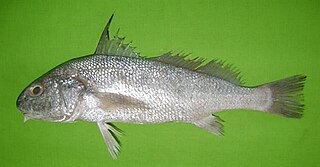
Johnius amblycephalus, the bearded croaker, also known as the green-backed croaker or sharp-nosed jewfish, is a marine ray-finned fish belonging to the family Sciaenidae, the drums and croakers. This fish is found in the Indian and Pacific Oceans.
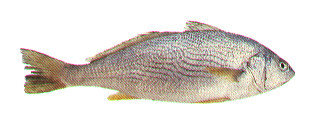
Umbrina is a genus of fish from the croaker family Sciaenidae. The genus contains 17 species occurring in tropical and warm temperate waters of the Atlantic, the Mediterranean, the Western Indian Ocean and the eastern Pacific.
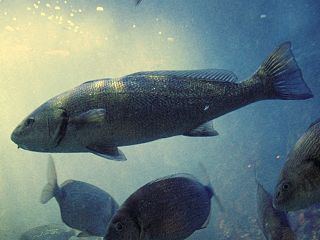
Umbrina cirrosa, the shi drum, is a species of marine fish from the warmer waters of the eastern Atlantic Ocean, Mediterranean Sea and the Black Sea. It is a commercially important species which is trawled for and farmed in aquaculture, as well as being a species pursued by anglers and spear fishermen for sport. The alternative vernacular names are gurbell, sea crow, bearded umbrine and corb.

Umbrina ronchus, the fusca drum, slender baardman, roncador, fusca croaker or slender tasselfish, is a species of croaker or drum from the family Sciaenidae which is found in the western Atlantic Ocean and the Mediterranean Sea.

Atractoscion is a genus of marine ray-finned fished belonging to the family Sciaenidae, the drums and croakers. The fishes in this genus are found in the Atlantic, Indian and Pacific Oceans.

Argyrosomus inodorus, the mild meagre or silver kob, is a species of marine ray-finned fish belonging to the family Sciaenidae, the drums and croakers. The species is found off southern Africa where it is an important target species for hook and line fisheries.
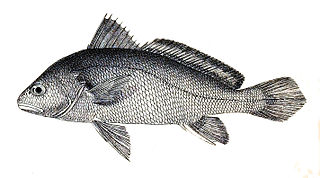
Nibea is a genus of marine ray-finned fishes belonging to the family Sciaenidae, the drums and croakers. The species in this genus are found in the Indo-West Pacific region.

Pseudotolithus senegalensis, the cassava drum, is a large fish found on the coast of West Africa. It can grow up to a maximum length of 114 cm with a common length of about 50 cm for adults. It is known as cassava croaker or croaker in some parts of West Africa.

Odontoscion dentex, the reef croaker or brown large-eyed croaker, is a species of marine ray-finned fish belonging to the family Sciaenidae, the drums and croakers. It is found in coral and rocky reefs of the tropical Western Atlantic, living as solitary individuals or in small groups at a depth of 1 to 30 m. This species feeds on small fish, shrimp, and larvae.

The Rio Grande marine ecoregion covers the waters offshore of the southern Brazilian states of Rio Grande do Sul and Santa Catarina. The ecoregion stretches along 500 miles of sandy beach coast, and 200 miles out to sea. The warm Brazil Current flows south through the region in parallel with the coast. The continental shelf is smooth and flat, with the bottom mostly sand and mud. Overfishing is a problem, but marine life in recent years has benefited from measures such as a 2018 ban on motorized shrimp trawler fishing within 12 miles of the Rio Grande do Sul coast. The Rio Grande ecoregion is one of four coastal marine ecoregions in the Warm Temperate Southwestern Atlantic marine province. It is thus part of the Temperate South America realm. .
Ctenosciaena is a genus of marine ray-finned fishes belonging to the family Sciaenidae, the drums and croakers. These fishes are found in the Western Atlantic and southeastern Pacific Oceans.
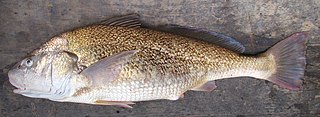
Micropogonias furnieri, the whitemouth croaker, golden croaker, hardhead, mangrove snapper, rocandoronco, two-belly bashaw, West Indian croaker, West Indian drum or whitemouth drummer, is a species of marine ray-finned fish belonging to the family Sciaenidae, the drums and croakers. This fish is found in the western Atlantic Ocean.

Odontoscion is a genus of marine ray-finned fish belonging to the family Sciaenidae, the croakers and drums. These fishes are found in the Western Atlantic and Eastern Pacific Oceans.

The boe drum is a species of marine ray-finned fish belonging to the family Sciaenidae, the drums and croakers. It is the only species in the monospecific genus Pteroscion. The boe drum is found in the eastern Atlantic Ocean off western coast of Africa.



















